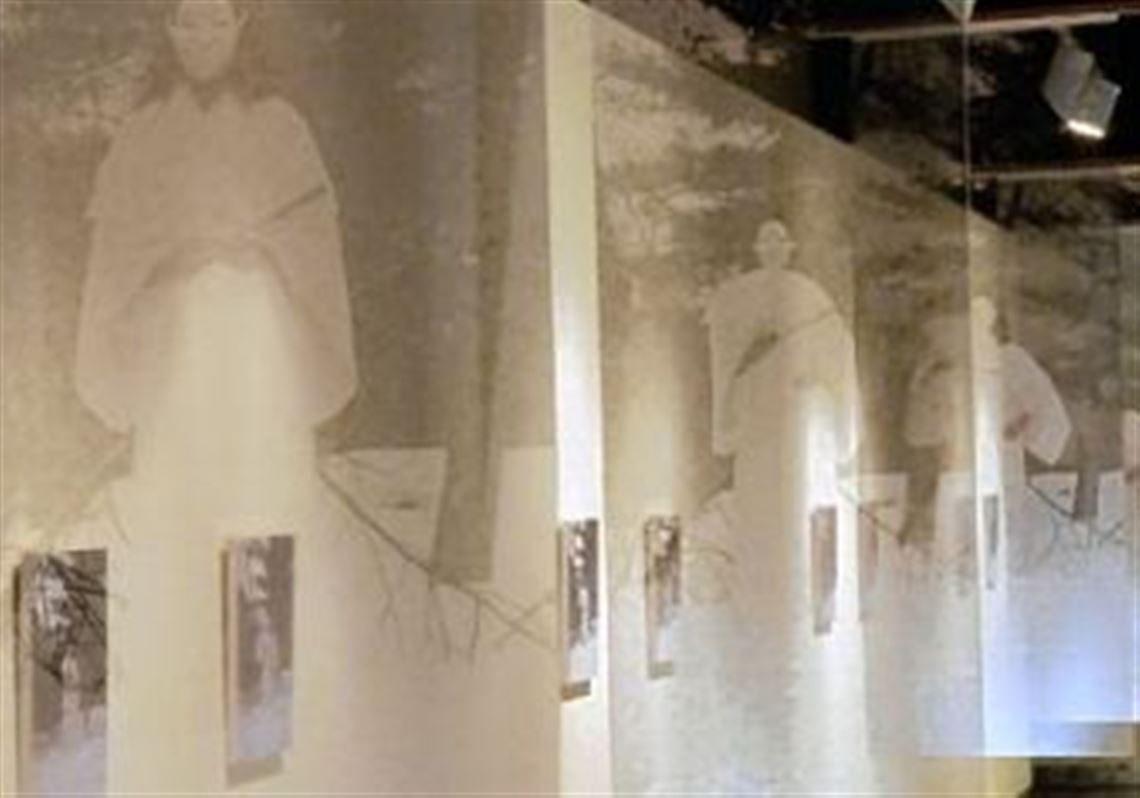Fumino Hora's exhibition at the Pittsburgh Glass Center is exotic yet accessible, spare yet brimming with objects, inspired by imperfection but perfect.
"The Way of Samsara" is an installation but comprises individual artworks that arise from aspects of Buddhism and from Ms. Hora's life experiences. As such it blends Japanese and global cultural constructs, self-portraiture and generically human concerns.
Samsara, Ms. Hora explains, is "a belief that all earthly beings are trapped in a perpetual cycle of birth, death and rebirth. And one can only escape from it by attaining the elusive spiritual state of Nirvana."
In the entry, six fragmented, cast-paper torsos hanging from the ceiling are visceral and call to mind imagery ranging from butcher shop carcasses to the dangling figures of Goya's gut-wrenching "Disasters of War."
That there are six is a reference to the "six realms of existence" or "six paths of reincarnation" that one may be reborn into. They are Deva (like a god), warrior, human, animal, hungry ghost, and Hell, and are determined by the Karma accumulated during one's present life.
In contrast, two light-filled, translucent glass figures, of a mature woman and a little girl, appear to add sweetness. But do they?
Ms. Hora has dubbed the woman, who is pregnant, Rosemary, an allusion to the 1968 movie "Rosemary's Baby." "She's carrying something. I don't say what."
The child is Ms. Hora's "signature figure," which takes the form of a Japanese doll wearing the traditional Chinese dress, a cheongsam. The artist, who was born in Tokyo, worked in Hong Kong from 1994 to 2006, a Japanese national living in a Chinese culture. The tension she felt under such circumstances also exists within the figure, projected by its stance: slightly sideways, slightly forward leaning.
"It is a subtle self-portrait as well," Ms. Hora says.
In Japanese culture, dolls will gain a soul if they are "cherished by their owners long enough," Ms. Hora says. Some believe they may pass their torments to dolls, which will accept the suffering in place of the humans.
The figure first appeared in her 2008 exhibition, "Doppelganger," at Pittsburgh Filmmakers. Then made of plaster, it was the first piece she created when she began studying at the glass center.
The play between distressed and sanguine, ragged and beautiful, are part of the aesthetic of Japanese Zen Buddhism, which Ms. Hora has researched extensively and which she incorporates into her artwork. She earned bachelor's and master's degrees in fine arts from The Royal Melbourne Institute of Technology University, Australia, and is currently a RMIT doctoral candidate. She arrived in Pittsburgh in 2006 and lives in Shadyside.
Zen aesthetics, she says, honors the imperfect, impermanent, incomplete, asymmetric and simple. It's also a recognition of the significance of the void, and an appreciation of wabi-sabi (a complex concept that, too simply put, celebrates the transcendence in natural cycles of death and decay).
Also at the entry is a video projected onto a small screen "secretively" set within a raised box the viewer must peer into. A woman in a white kimono, her hair long and dark, her face covered by a white mask, moves slowly, delicately, as a Zen monk chants in the background. Snow falls continually against the backdrop of tall evergreens.
The eight-minute work was stylistically inspired by traditional Japanese Noh theater. Ms. Hora filmed it during a February 2010 snowstorm, spending two hours a day for a week in the chilling cold. But you wouldn't know that to watch the lovely and wistful film, the snow as insistent as the passing of grains in an hourglass, beautiful and threatening.
And transient, Ms. Hora points out.
"The video work symbolizes disappearance. We look at the record of what happened before. The subject doesn't exist anymore, like you are searching for something that is missing."
Ms. Hora argues that media like video and photography have a connection to Zen aesthetics because of their component of impermanence. Similarly, she finds performance and installation to be good fits for her work. Paper and glass are, too, having fragility compared to more historically accepted media such as oil and marble.
From the entry area, the visitor is drawn into a larger space by a series of banners that peel away the outer world layer by layer. The large organza sheets, digitally imprinted with images of the woman in kimono, appear ephemeral in their whiteness, translucency and by the slight motion caused when passing them.
The space has a spiritual quality but was not drawn from a specific denomination. Buddhist temples were an influence, she says. Ms. Hora also investigated such sites as the Mark Rothko Chapel in Houston to see "how a spiritual or meditative space is constructed. [The Rothko Chapel] is very calm and very minimalist. I was impressed by that. But, I'm not minimalist."
Between rows of banners are a cast glass torso and a pair of feet, each bound with rags or chains, pierced with nails and rusting -- imperfection, inherent and insinuated, physical and metaphorical.
A glass face surrounded by arms is titled "Sen-ju: The one who can hear all cries of the world." Sen-ju is a Bodhisattva, a being who has reached enlightenment but has renounced Nirvana to help others. Sen-ju so wanted to help everyone that her hands split into thousands.
A dozen more of the doll figures, slightly smaller in size, ascend a spiral ramp at the gallery's far side. They have a second layer of inspiration beyond her personal one: Jizo, another popular Bodhisattva, who is represented throughout Japan by small stone statues that are male and less demure than Ms. Hora's "signature." Jizo assists travelers and saves children who die young or before birth.
The highest figure looks toward a large painting on the back wall comprising a huge ring of rust on abaca paper. It suggests a Zen ink brush circle painting, wherein the white and black areas hold equal weight. The rust flares into a fiery circle, forming a portal to the vastness of nothingness within it and beyond -- a halo, glowing yet tarnished, inviting contemplation of the inconceivable.
"Samsara" has been extended through Jan. 25 at 5472 Penn Ave., Friendship. Hours are 10 a.m. to 7 p.m. Tuesdays through Thursdays and 10 a.m. to 4 pm Fridays and Saturdays. Admission is free; ring doorbell for access. Information: 412-365-2145 or www.Pittsburghglasscenter.org.
I was privileged to be among the first to see Pittsburgh filmmaker Ken Love's new, just short of ready for public screening, documentary on the late artist Maxo Vanka and the murals he painted in St. Nicholas Croatian Catholic Church in Millvale. The rich film brings the murals and the small ethnic parish to life as well as showing the vitality of the immigrant communities that built Pittsburgh.
Barbara Jones will lecture on "Picturing America: Works on Paper in the Permanent Collection" at noon today at the Westmoreland Museum of American Art, 221 N. Main St., Greensburg. The free brown bag talk is the beginning of a series on the making of the museum's new permanent collection catalog, "Picturing America" ($45, hardcover). Author and museum chief curator Ms. Jones and contributor and museum director/CEO Judith O'Toole will sign copies afterward.
First Published: January 12, 2011, 10:00 a.m.

















